April 16 More ‘Roos (Day 202)
Today we went for a drive to the nearby community of Port Sorell, across the Rubicon River Estuary from the park. There are a few walks we wanted to try around the area. We were surprised to learn that this river inlet at Port Sorell has been a boat-building hub since the mid 1800’s!
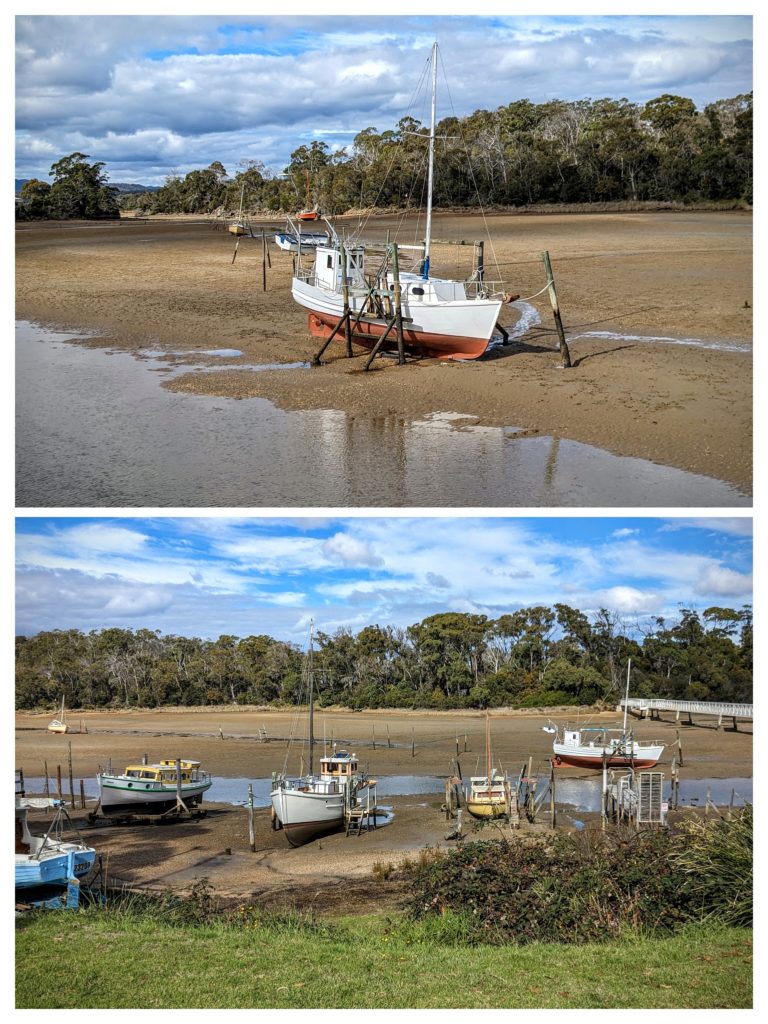
The tide was out and the boats were beached! Apparently that makes it ideal to work on building boats. We heard power tools being used somewhere down the riverfront as we crossed the footbridge into the conservation area.
The walks were short so we were back at the park in a few hours. I spent some time in the Visitors Center learning about the various animals we have not seen, due mostly to them being nocturnal, and us being asleep then!

The Tasmanian Devil (in the top photo) population in the park has been severely affected by Devil Facial Tumour Disease (DFTD). The Wildlife Service is working with Universities to identify the cause of the disease and formulate a vaccine if possible. The Tiger Quoll (bottom photo) is a new specie to me and has a very interesting natural history!
Another animal we haven’t seen, except as roadkill a few times, is the Wombat. I read about it in the Visitors Center and learned that researchers received an Ig-Nobel Prize for studying how wombats make square poop! As to why they make square poop there are lots of theories! Unfortunately here at the NP the wombat population was decimated by an epidemic of mange that killed most of them, but they are slowly recovering. Walking back to the camper I spotted this beautiful bird feeding on the cones dropped by the she-oak tree across from our site.

The Green Rosella is beautiful and common, although this is the first one I’ve seen! You can see the many cones dropped by the tree that the bird can choose from!
As evening approached we took a short walk to the “Kangaroo Lawns” around the Visitors Center, created by the many marsupials that are found in the area that graze the grassy fields at dawn and dusk.

The forester kangaroos were joined by the smaller wallabies in the glow of the evening light.
The last animal sighting I’d like to share with you is one of which I could never get a good picture of, but we saw many of them around the camper. The Roufous Bellied Pademelon likes to stick to the edges of the bush, it is the smallest (and cutest) of the kangaroo-looking animals, and at first I thought they were young wallabies. We enjoyed our three nights here at Narawntapu NP, it was peaceful and a great chance to see some of the wildlife of Tasmania!
April 15 A Mob of Kangaroos (Day 201)
We were greeted this morning by a friendly (?) curious, maybe begging (?) wallaby!
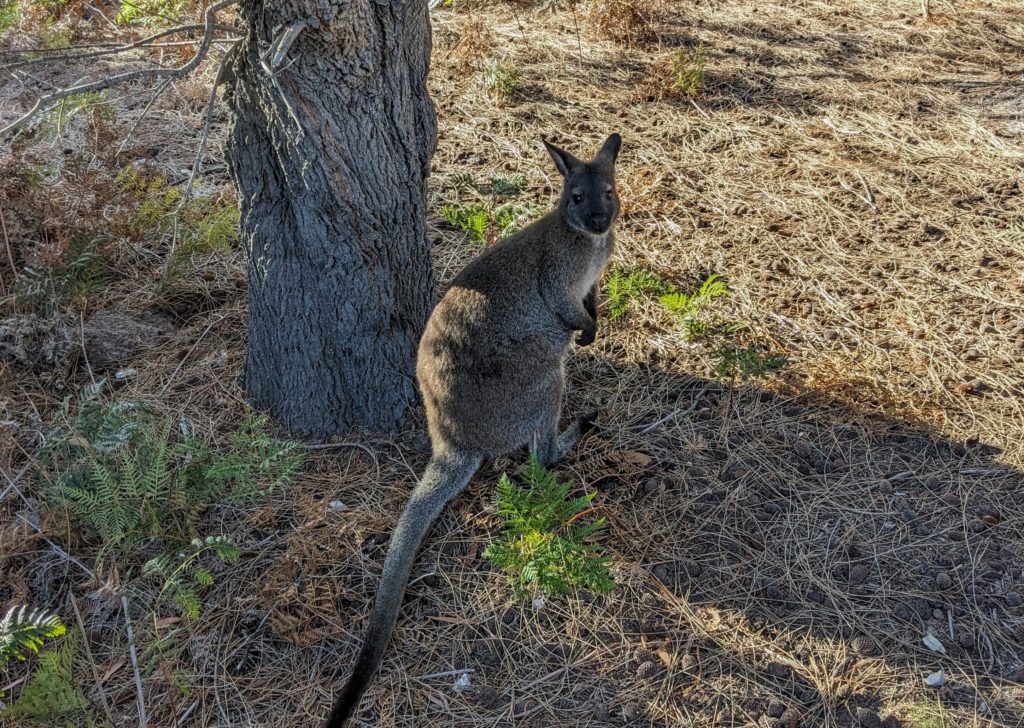
It hung around for quite awhile, maybe expecting some food, but all signage and literature admonish visitors to NOT feed the wildlife!
After he finally sauntered away we decided to move to the campground closer to the Visitors Center from which most of the hiking trails are located. We packed up and rattled back over the washboard gravel road to the Visitors Center where we upgraded to a powered site! We set up camp, had lunch and started off on our first hike to the Bird Blind!

The trail took us into a eucalyptus forest that appears to usually be marshy, but the dry summer conditions have parched it!

At the bird blind we found the marsh and observed several duck species and this black swan through cut outs in the wall of the hut above the marsh.
From the blind we continued our hike through the woods and into sand dunes that we hiked through and over to reach the long sweep of Bakers Beach.
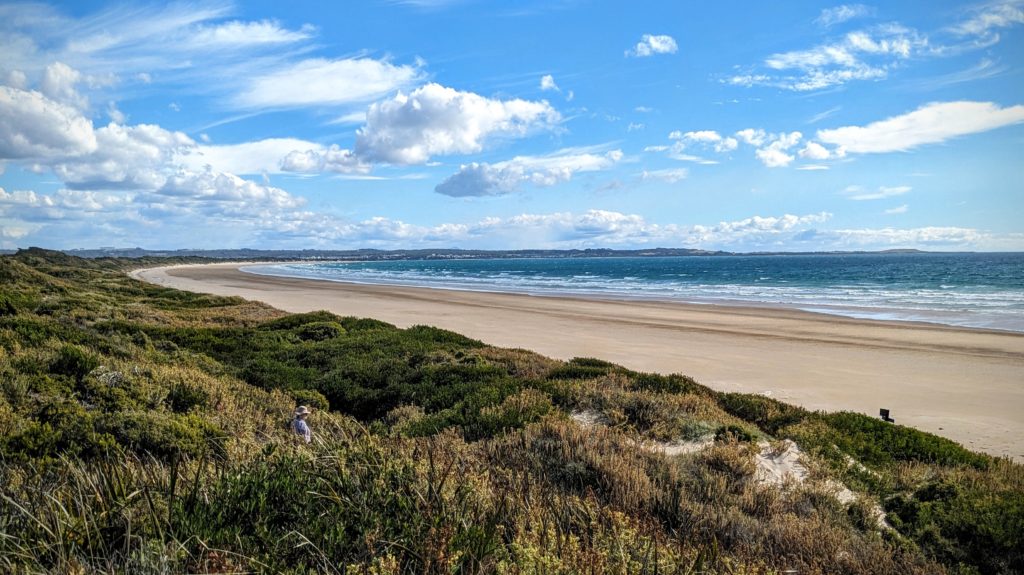
Looking west towards the end of the peninsula where we camped last night at Bakers Point.
We walked east for several km along the deserted beach, seeing only one other hiker and a few birds. We reached another trail that led inland to Archers Knob, a hill that overlooks the beach. We decided we would try the hill and see how far we could get!

Halfway up the Knob we could see the full sweep of Bakers Beach to the east with Little Badger Head and the more distant Badger Head extending out to sea!
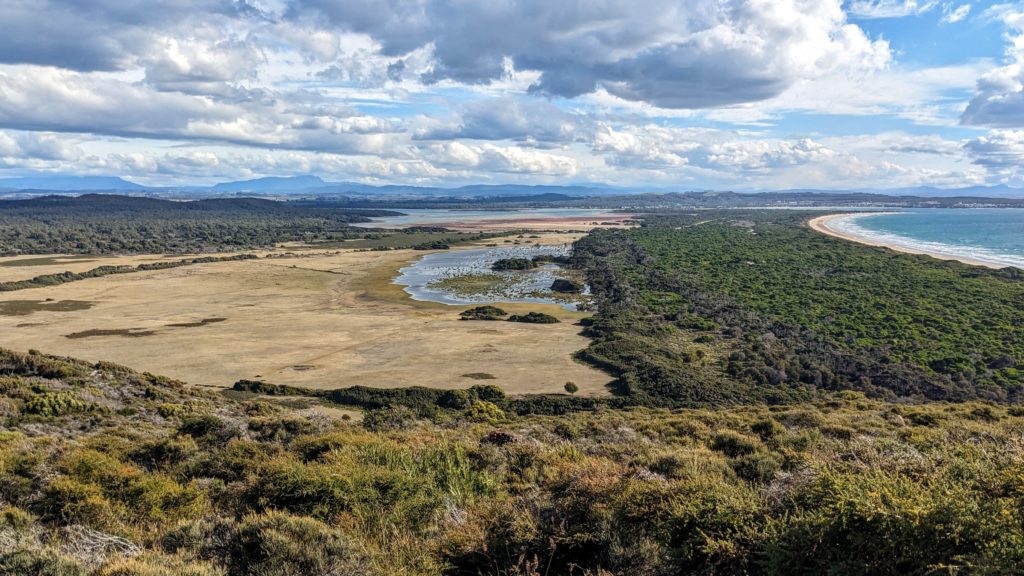
From the loop trail on the top of the Knob we looked west down onto the marshlands and ex-cultivated fields of the park, with the eastern sweep of Bakers Beach on the right.
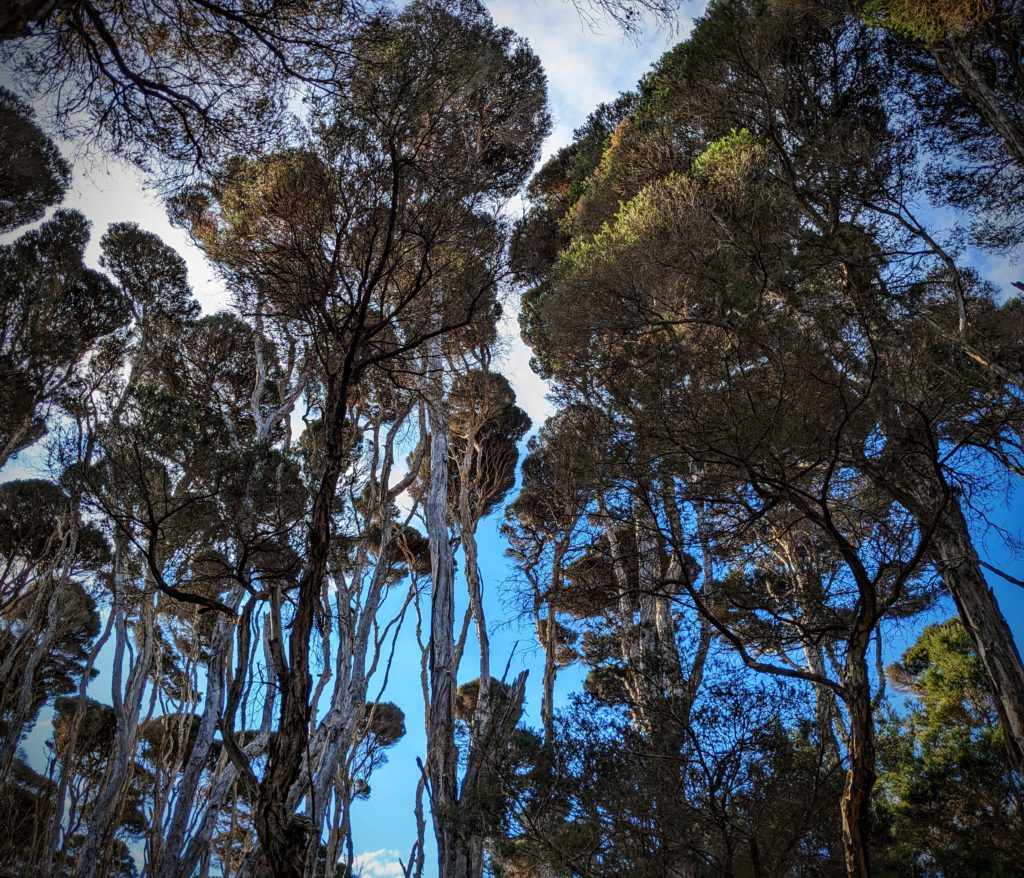
We hiked down off the Knob and through a Eucalyptus forest.
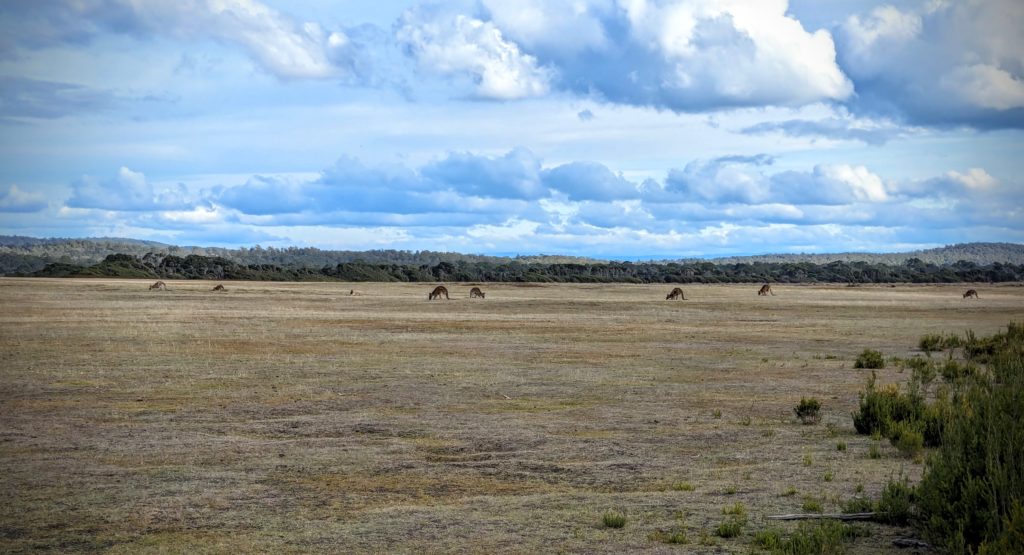
We emerged from the forest onto the fields we saw from the top of the Knob, and into a mob of kangaroos! So that’s what those dots were we saw from the top!
These are actual kangaroos! The big kind, although not as big as the red and grey ‘roos on the mainland. Forester kangaroos are concentrated here at Narawntapu NP and the males can get as big as 2 meters (6.5 ft.) tall and weigh up to 60kg (132 lbs.)! They seemed indifferent to us unless we got too close, then they would casually hop away and continue grazing. We completed our loop hike and were surprised again at our campsite which was filled with wallabies grazing around the campers!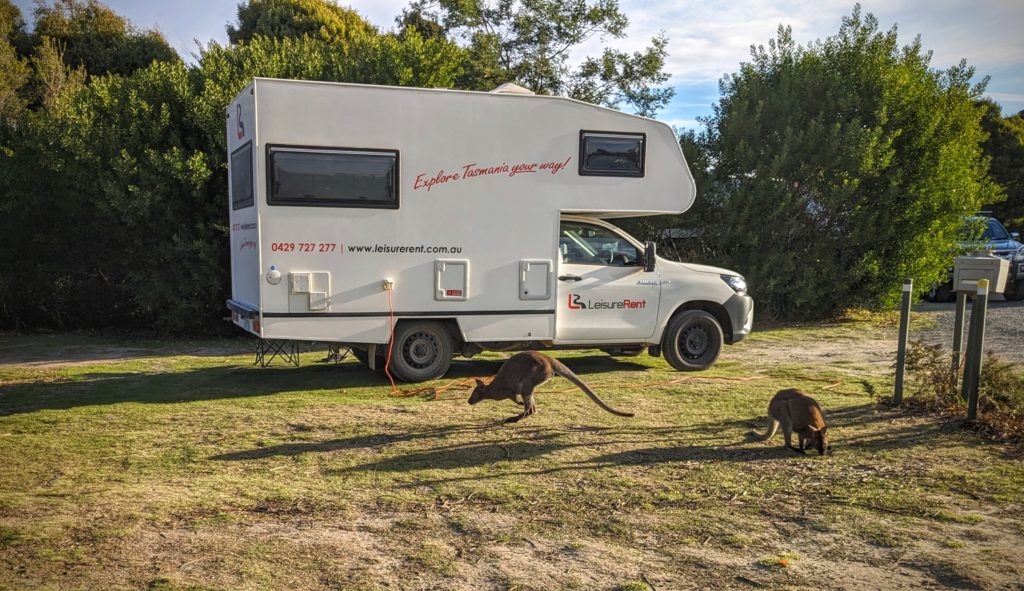

I felt a little guilty making dinner! But the wallaby spaghetti sauce was delicious!
April 14 Narawntapu National Park (Day 200)
We moved about an hour east today, to Narawntapu National Park, a rather remote park on the north coast between the Rubicon River estuary on the west and the River Tamar Estuary on the east. The weather was bright, sunny and warm, but windy! We chose the furthest campground on the washboard gravel road, at Bakers Point on a sandy peninsula that forms the east side of the Rubicon River estuary. We set up camp and went for a walk to explore the area.
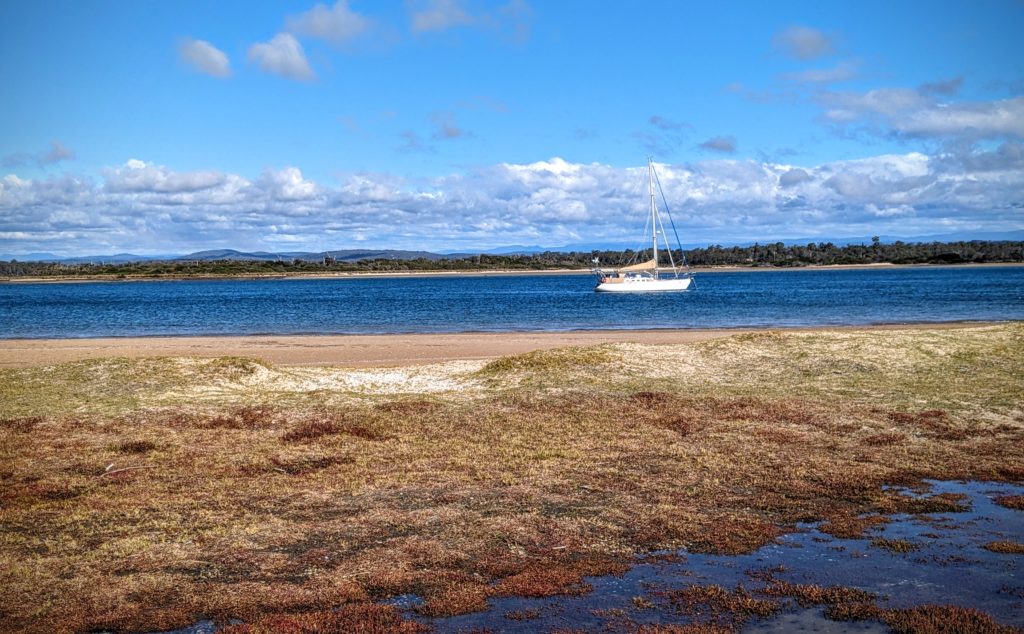
A single sailboat was moored in the northeast arm of the estuary, protected from the winds blowing in from the sea.

We came up on a wallaby, seemingly unafraid of us, until it decided we were too close and bounded away!

When we rounded the bend of the peninsula the wind hit us full force! We decided to head back to camp, in the trees, protected from the wind!
April 13 Back in Penguin (Day 199)
We went back into the town of Penguin today for resupply and free wifi for an hour.
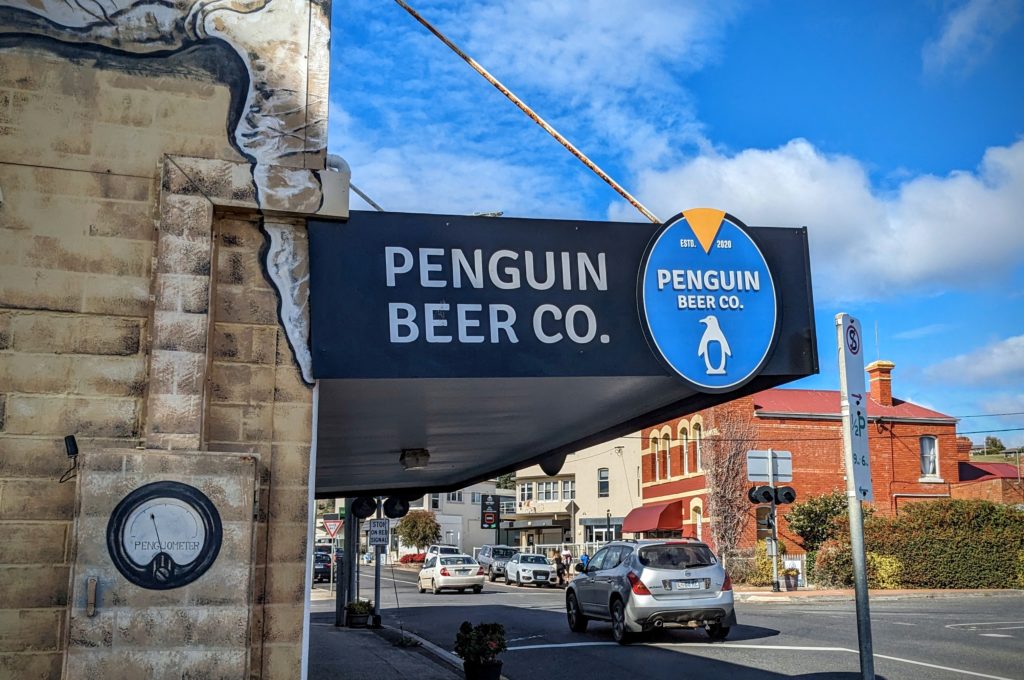
The free wifi spot is next to the Brew Pub, unfortunately we were there about 3 hours too early!

The park where we fill with potable water has a great beach!
We returned to the Midway Point camping site for another free night to wait out the windy conditions.
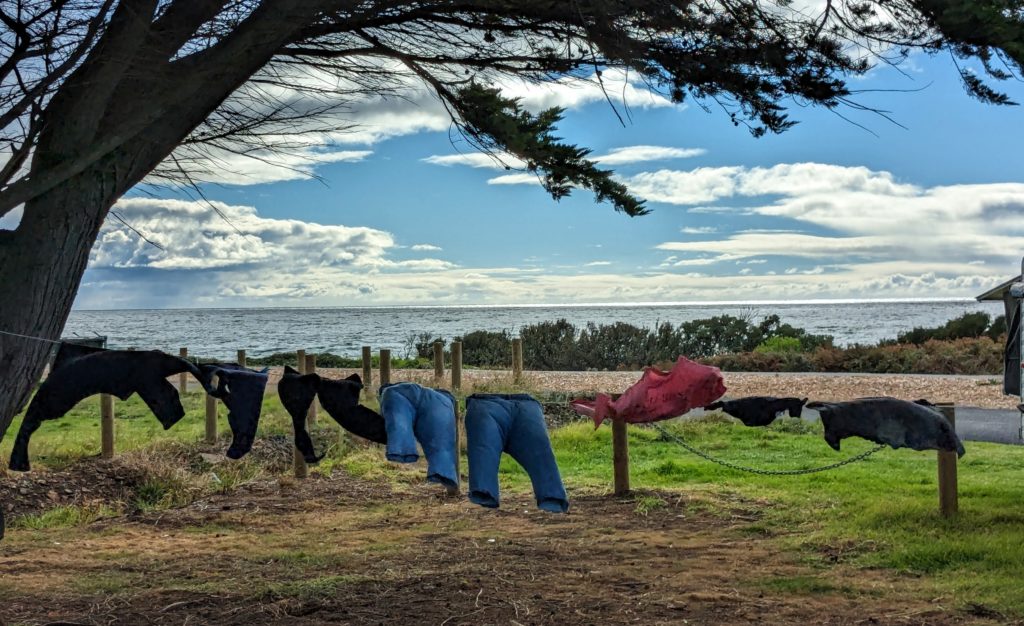
The neighboring campers had their laundry drying on the line, great wind socks (pants)!
April 12 Highfield (Day 198)
We started the day going into Smithton to shop, get water and dump and we noticed the Tarkine Oyster shop across the Duck River inlet! Of course we had to have some lunch!
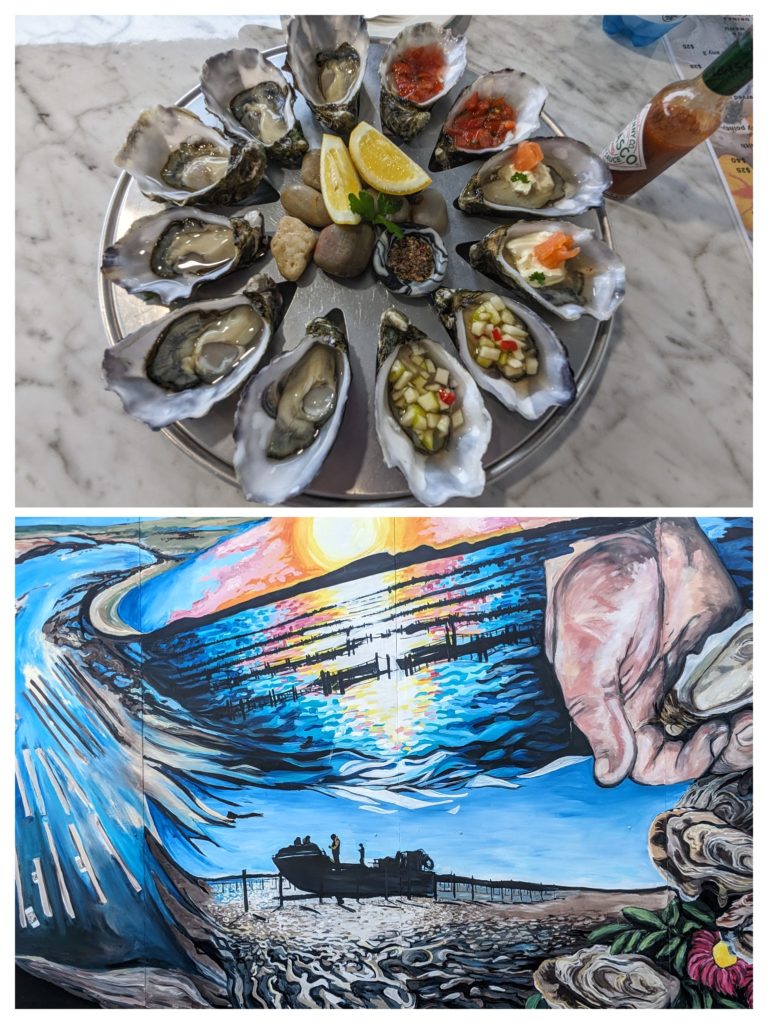
Our first tray of 6 ‘au naturelle’ and 6 raw with a variety of toppings. We decided to do another dozen, half with the mignonette and half with the salmon and creme fraise! The mural outside the building was quite striking!
After our wonderful raw lunch we headed up to the 3rd ‘cape’ on the north coast, to the small town of Stanley that is at the base of “The Nut”, a flat topped volcanic butte similar to the Table Cape we visited on April 9. It was a raw, cool windy day so we headed to the historic site of Highfield to do some indoor exploring.
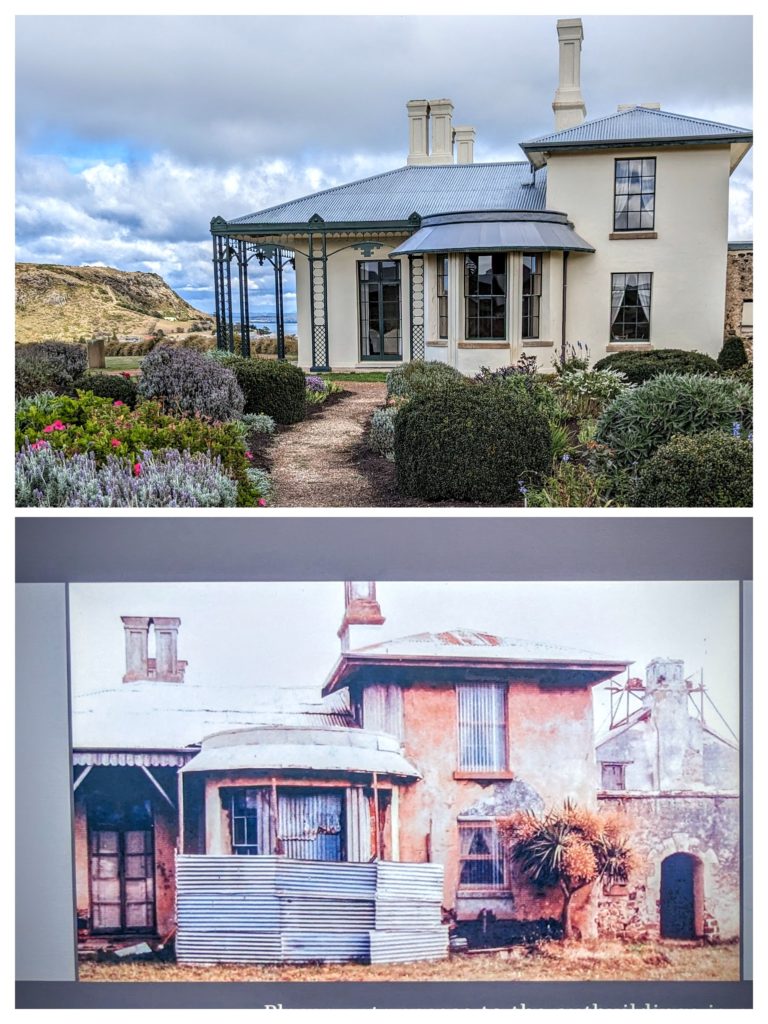
The estate as it is today after extensive renovation, and the estate as it was in 1990 when it was acquired by the Parks and Wildlife Service.
Highfield was the headquarters of the Van Diemans Land Company and was constructed in 1826 mostly by convict (slave) labor! It is a wonderful example of early colonial architecture and a testament to the horrible practice of transportation to “the ends of the earth” for minor crimes and subsequent slave labor practices.
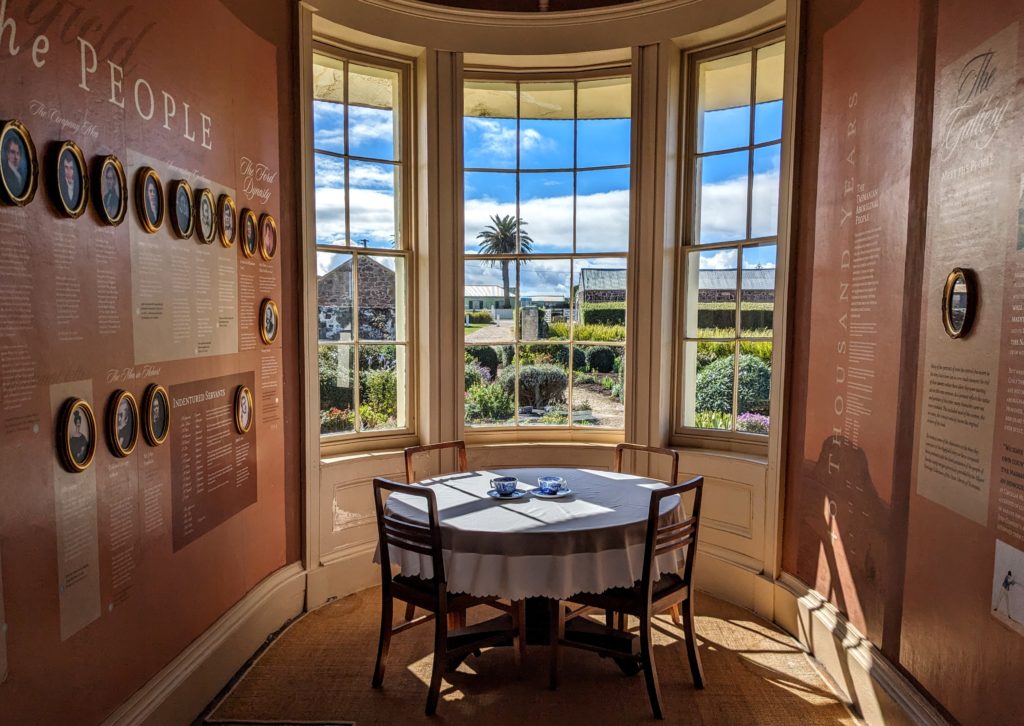
The Gallery, where visitors were greeted. Now it serves to introduce visitors to the main characters of the colonial period here.
The Parks Service does not sugarcoat the history here. The Van Diemans Land Company began their holdings here in 1826 and by 1834 the last remaining 134 Aboriginal people were banished to Flinders Island and nearly all were dead by 1850. The main architects of this program were the leaders of the Van Diemans Land Company.
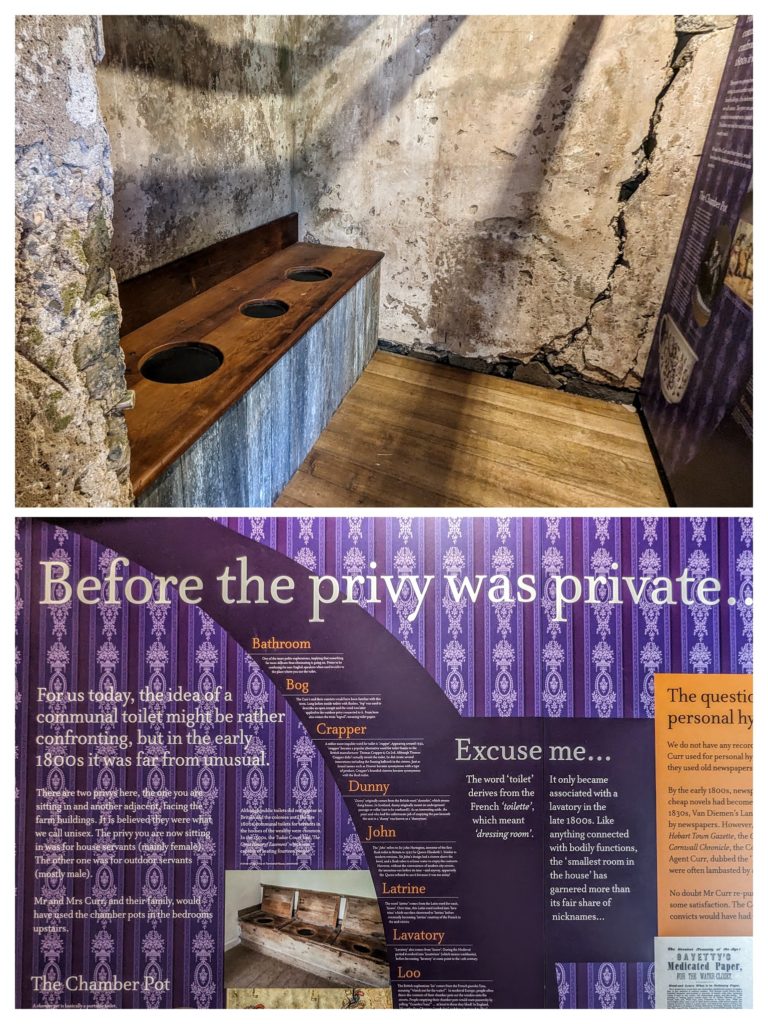
The most important room in (actually outside!) the house! And some very interesting history of “the ‘loo”!
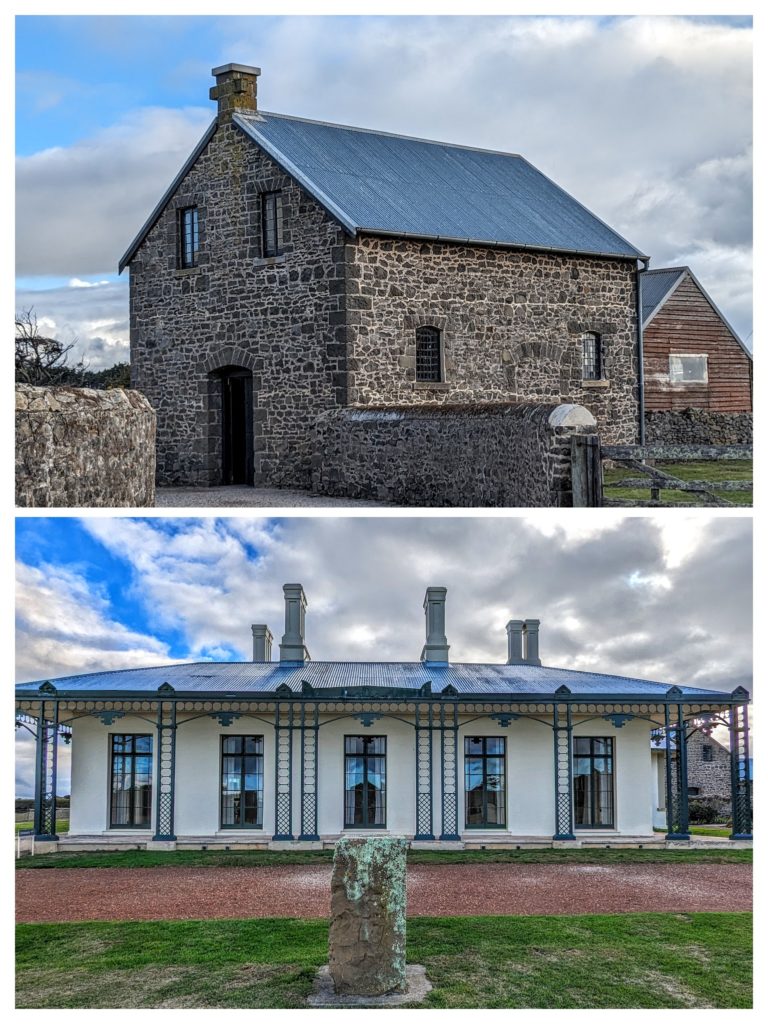
Among several outbuildings is the chapel/schoolhouse, with a cross built into the chimney. The side view of the estate house shows the simple, elegant Regency style, early for it’s time.
The estate is rather large and I spent lots of time reading all the history. When we finally left we found a camping site back at Midway where we had spent April 9th. We had a relaxing evening and saw the sliver of moon over the calm waters of Bass Strait.

























